Research Article - (2023) Volume 7, Issue 1
Effect of Male Rabbit Urine on Aggressiveness and Affiliative Interactions in Group-Housing of Unfamiliar Mature Females
Eva Cepeda*,
Elisabet Tetas,
Albert Perez and
Francisco Perez
Department of Safety and Animal Welfare, Les Franqueses del Valles, Spain
*Correspondence:
Eva Cepeda,
Department of Safety and Animal Welfare, Les Franqueses del Valles,
Spain,
Email:
Received: 14-Feb-2023, Manuscript No. ipjaslp-23-15707;
Editor assigned: 16-Feb-2023, Pre QC No. ipjaslp-23-15707 (PQ);
Reviewed: 02-Mar-2023, QC No. ipjaslp-23-15707;
Revised: 07-Mar-2023, Manuscript No. ipjaslp-23-15707 (R);
Published:
14-Mar-2023, DOI: 10.36648/2577-0594-7.1.07
Abstract
Rabbits are one of the most used animals in biomedical research. Despite being social animals, they are usually kept individually in cages in the research facilities. One limitation to the group-housing is aggression when mixing strange adult animals. Some studies have shown that male urine is effective in decrease the aggressiveness between female animals. We evaluated the behavior of two groups of 4 unfamiliar adult female New Zealand White rabbits for 4 days. One group was sprayed with buck urine prior to the formation of the group, and the other group served as control. The animals were tested in a large pen with an enriched environment to facilitate social housing. The results showed no main effects of treatment on the studied behaviours (aggression, social and agonistic behavior, allogrooming and mounting). In both groups, the frequency of attacks was highest the first day and decreased considerably by day 4. Regarding social and agonistic behaviors, both increased progressively from day 1 to day 3, and decreased from day 3 to day 4. The food intake and body weight of the animals during the study was also similar between the groups. No remarkable lesions were found in any animal. The findings indicate that urine had little or no effect at reducing aggression between the animals. Nevertheless, the adaptation of the animals to the groups was easily achieved within a few days. We propose to provide a large space and an enriched environment to facilitate the socialization of unfamiliar female adult rabbits.
Keywords
Rabbit; Agonistic behavior; Allogrooming; Mounting; Environment
INTRODUCTION
Wild rabbits live in large groups (colonies) composed of different breeding groups. Within each social group, which consists of 1-4 males and 1-9 females, both females and males develop an independent dominance hierarchy. Males compete for the access to females, while females defend their nesting sites [1,2]. Dominance is established by constant patrol of territory, and by fighting or by aggressive display by the dominant bucks [3]. For their part, females can be as aggressive towards subordinates as the males [4]. Once the hierarchy is established, fighting is generally avoided by the secondary individuals and the rank order is maintained as long as the group composition remains intact [3]. Only with the introduction of a new male to the colony or the removal of the top-ranking buck, the ranking
order will have to be quickly re-establish, with new fights [4].
As rabbit domestication is quite recent the ethogram adopted by the domestic rabbit is comparable to the normal ethogram of the wild rabbit [5,6]. The spacing behaviour is also similar to that of the wild rabbit.
Rabbits have a complex social activity that cannot be duplicated in individual housing systems [7]. In near-natural conditions, domestic rabbits spend up to 90% of their resting time periods in body contact with one or more other rabbits [8]. So, in order to prevent stereotypes, it is important to permit the complete expression of their behavioral pattern [6-9]. And, probably group-housing is part of the solution.
For intensively reared animals, group housing poses no management problems. Fattening rabbits in medium-sized groups (7-10 rabbits) is a common practice in most commercial rabbit production countries [6]. No affectation of the sanitary status or the growth performance has been seen with this housing system. The relatively young age of rabbits at slaughter prevents aggressiveness among animals as fighting become more frequent with puberty [10].
With respect to breeding does, group housing usually results in chronic stress, aggressiveness and injuries [2-11]. The semigroup system also has failed to solve these problems [12]. Currently, the individual housing with an adequate enrichment is the recommendation for this type of animals [9-10].
Group housing of immature animals is achieved without major incidents [15-17]. But there is a problem when adult animals must be grouped together, especially males [18,19]. That’s a limitation in the laboratory setting where animals may be kept for long periods of time. In these animals, fighting is the most common cause of traumatic injuries [20]. In males, castration can be a solution in some cases, especially in long term studies. In the case of females, they can be in groups as long as they are siblings or have been reared together from weaning [16,25]. If new groups of adult animals have to be done, fighting will occur during the establishment of the dominance relationship [22-25]. Approaches are needed in order to try to solve this problem in the experimental facilities.
In wild colonies, the alpha buck marks the rabbits of his breeding group with urine [26]. This fact appears to play an important role in maintaining the social hierarchy. In fact, there are papers reporting a positive effect of urine in the reduction of aggression between does [27-29].
We wanted to test this finding in our facility. So, in the present study, the effect of buck urine was assessed in adult female New Zealand White rabbits. For this purpose, two groups of 4 unfamiliar animals were formed. In the treatment group, females were marked with male rabbit urine before housing them together. The behaviour of the animals was evaluated and recorded for 4 days. The results were compared to those obtained from the control group.
Our hypothesis is that the animals of the treatment group would show less aggressive behaviour and more affiliative interactions toward its group mates than the animals of the control group.
Materials and Methods
Animals and Housing
8 female rabbits (Oryctolagus cuniculus L.) supplied by a local breeder were used in this study. At the beginning of the experiment, the animals were one year old and had lived in pairs in double-wide cages.
The experiment was performed in a 2.23 x 2.23 m indoor enclosure (1.24 m2 per animal). Lights remained on between 07.00 h and 19.00 h. The pen was bedded with straw, furnished with 3 platforms, 2 wood structural elements and 2 nipple drinkers and 2 feeders. The animals had ad libitum access to commercial rabbit pellets, water and hay. Playing materials were used in the form of wooden sticks, cardboard tubes and paper balls (Figure 1).
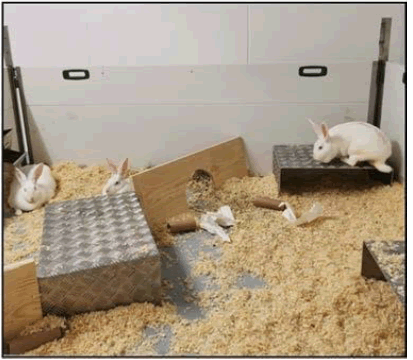
Figure 1: Enclosure of the experiment. The platforms provide elevated areas and places to hide. The wood structural elements create two different areas inside the pen.
During the study period, the mean temperature and relative humidity were 16.9ºC ± 0.6ºC and 85.9% ± 2.7%, respectively, for the control group, and 17.7ºC ± 1.1ºC and 65.7 ± 10.0%, respectively, for the treated group.
The mean weight of the control group and the treatment group, before start of the experiment, was respectively 5.30 kg
± 0.69 kg and 5.42 kg ± 0.60 kg.
Experimental Treatments
The females were sorted into two experimental groups of 4 animals each: Control and treatment group. Each group included non-sibling and unfamiliar subjects.
The trial was performed in two phases, one week apart. In phase 1, the control group was tested, and in phase 2, the treatment group was tested.
At the start of the experiment, the animals were taken for a 2 minute walk around the indoor corridors of the facility. It is thought to create a bonding between the animals in front of a stressful situation. The does were introduced to the pen at the same time in order to reduce territoriality. Recording of the behaviour was initiated 5 minutes after mixing the animals. The observations were made every hour for 15 min periods, between 0800 and 1400 am, over 4 consecutive days. Females of the treatment group received 1 mL of urine in their foreheads 2 times: When the animals were removed from their original cages, before the walk, and before they were mixed. Also, urine (20 mL) was also scattered all over the pen before the animals were introduced. Urine was collected a few weeks before from a male of a local vendor and was maintained frozen until the day before the experiment.
The animals were weighed before and after the observation periods. Food intake was daily monitored for both groups to compare the consumption during the trial.
Behavioural Observation
Interactions between the animals were recorded according to the ethogram described in Table 1. The observer stood approximately 0.5 m away from the pen. No interactions occurred between the observer and the rabbits during the observations.
| Type of behaviour |
Description |
| Attack |
When an animal attacks, chase or bite a group-mate |
| Agonistic interaction |
When two animals establish contact, and it results in one attacking the other |
| Social interaction |
When two animals establish contact but with no aggression |
| Mounting |
When a female tries to mount a group-mate |
| Allo-grooming |
When an animal grooms another |
Table 1: Ethogram with description of each behaviour
For all the behaviours, frequencies were considered. Only for aggression, the identification of the animals involved in the activity was recorded.
Interactions were counted as new interactions after an interruption of two seconds occurred or when the animal exhibited behaviour. Interactions were recorded separately for each time and day.
Measures of Injuries
Before mixing and during the study all animals were examined for injuries. The injuries were classified into four degrees of severity following the method described by Graf [30]: Marginal injuries (degree 1), slight injuries of max. 0.25 cm2 (degree 2), medium grade injuries extending to the connective tissue or over 0.25 cm2 (degree 3), palpable haematoma or injuries of the palpebra, and severe injuries as deep and heavily bleeding wounds and injuries to the genital or the eyes (degree 4). If there was an animal with a 2-degree lesion, the monitoring will be increased. If there was an animal with a 3-degree lesion, it will be retired from the experiment. And, if there was an animal with 4-degree lesion, it will be euthanized.
Statistical Analysis
The software package SPSS (Version 15) was used for all statistical analyses. Attacks, social interactions, agonistic interactions, mounting and allogrooming behaviours were analyzed using general linear model (GLM) analysis. The experimental group (control and treated) and the study days (1-4) were treated as fixed factors. Differences within each group for the study days were analyzed by means of one factor GLM.
Results were considered as statistically significant when p ≤ 0.05.
Results
Behaviours
Attack was the most frequent behaviour the first day (81.8% and 90.2%, control and treatment groups respectively). Since then to the end of the experiment, attacks decreased progressively (p<0.01). The treatment group performed more attacks than control group on day 1 (p=0.026), but there were no statistically significant differences the rest of the days (Figure 2).
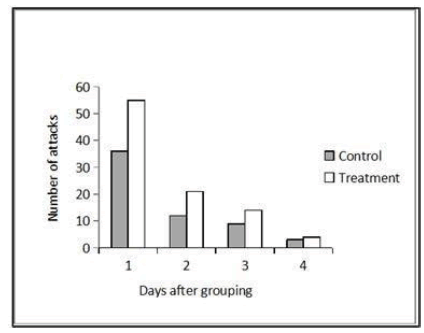
Figure 2: Number of attacks during the study in control and treatment groups.
The animal n º 1 of the control group caused most of the attacks (83%, 100%, 89% and 100% from the total of attacks, for days 1, 2, 3 and 4, respectively). In the treatment group, the attacks were performed mainly by animals n º 2 and 3 (Figures 3 and 4).
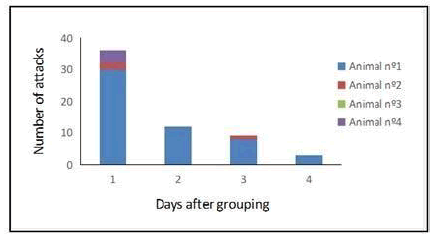
Figure 3: Number of attacks performed by the animals of control group.
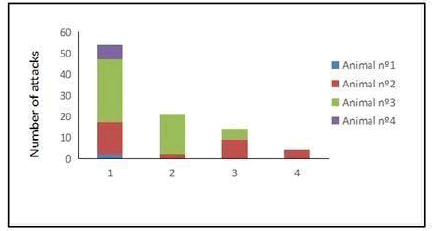
Figure 4: Number of attacks performed by the animals of treatment group
In both groups, the frequency of agonistic interactions increased progressively from day 1 to day 3. At day 4 the frequency decreased (Figure 5). The treatment group performed more agonistic interactions on day 4 than the control group (p=0.07).
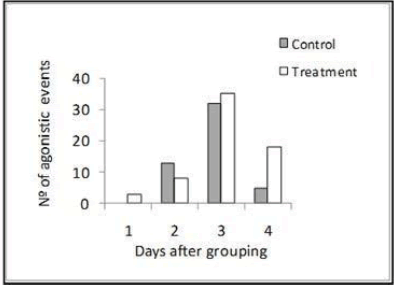
Figure 5: Number of agonistic events during the study in control and treatment groups.
Social events increased progressively from day 1 to day 4 in the treatment group (p<0.01), and from day 1 to day 3 in the
Social interaction with no aggression control group (Figure 6). Between groups, there were not statistically differences except for day 2, where the number of social interactions was significantly higher in the control group (p=0.008).
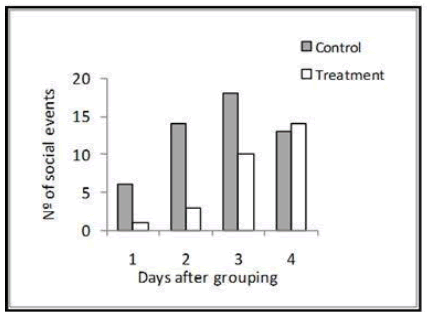
Figure 6: Number of social events during the study in control and treat- ment groups.
A trend toward an increase in the frequency of allogrooming behaviour was observed from day 1 to day 4 in both groups, but without statistically significant differences (Figure 7).
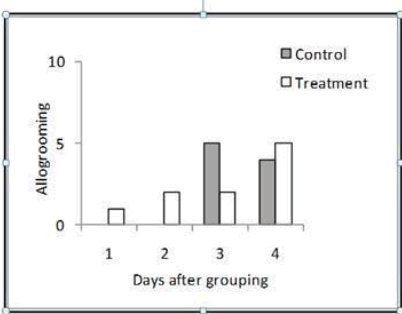
Figure 7: Number of allo-grooming events during the study in control and treatment groups.
Regarding mounting behaviour, there were no differences between groups or between days, also any tendency (Figure 8).
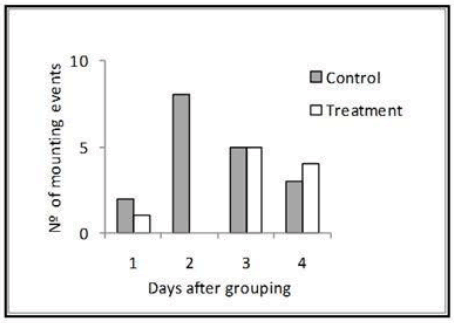
Figure 8: Number of mounting events during the study in control and treatment groups.
Body Weight
The body weight of all the animals decreased during the experiment by 5.26% (mean 0.279 kg) and 4.13% (mean 0.224 kg) for control and treatment group, respectively (Figure 9).
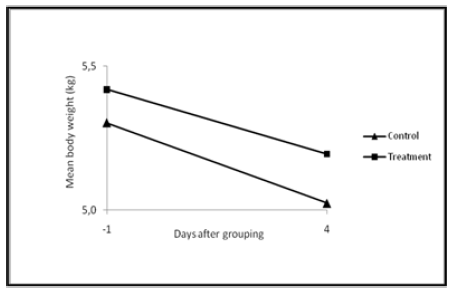
Figure 9: Body weight of the animals
Food Intake
The daily food intake increased progressively from day 1 to day 4 in both groups (Figure 10). The total increase was 160% and 230% for control and treated groups, respectively. No differences were found between groups.
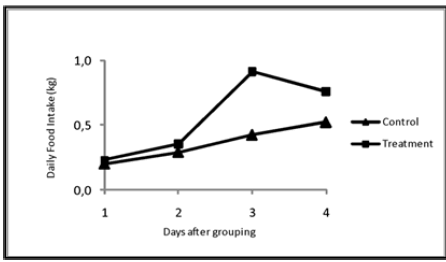
Figure 10: Daily food intake of the experimental groups
Injuries
The animals were observed for lesions after grouping and every day until the last day of the study. Only a 1st degree injury occurred in one animal from the control group.
Discussion
There are some limitations to group-housing of rabbits in the experimental facilities. The impossibility of tracking the food intake per animal, limited space or a more difficult individual clinical monitoring is some examples. However, one of the main problems associated to group-housing is the high incidence of fighting and injuries, especially between sexually mature animals. For this and other reasons, experimental rabbits are usually kept in cages.
In the current study, we evaluated whether buck urine may influence the aggressive behaviour when mixing unknown mature females. For this purpose, four animals were sprayed with male urine before grouping them in a novel pen. The behaviour of each animal was observed and recorded for 15 minutes, at 1 hour intervals and for 4 consecutive days. The results were compared with those obtained from a control group of identical characteristics.
In general, no statistically significant differences were observed in the groups regarding the evaluated behaviours. Attacks started immediately after mixing the animals in both groups, as published by another author. Attacks occurred during all the observation periods of the first day. The following days, aggressive events decreased substantially and in a gradual manner.
Agonistic and social interactions were very low the first day and then increased progressively until day 3, in both groups. The last day of the study, the activity of the animals was very low. This fact suggests that a social structure was successfully achieved in only 3 days. Other authors have reported a similar duration for the establishment of the hierarchy [25,31]. Despite the intense activity observed the first days, no significant injuries occurred in the animals.
Some authors found that aggression occurred especially in the early hours of the daytime [23,32]. However, in the present study, a correlation between the number of aggressive interactions and the time of the day was not observed. It seems reasonable because the animals, in a new group, have the priority of establishing a social hierarchy.
Mounting and allogrooming behaviours were not influenced by the addition of male urine to the animals. Mounting between animals of the same sex is considered a type of agonistic behaviour [11-33]. But, no differences were seen between groups or within the rank order of the animals as reported in the literature. In the control group the animal that performed more attacks was the one that displayed more mounting behaviour (78% of the total of the group). However, it was the opposite in the treatment group, where the animal that showed less aggressive behaviour was the one that performed more mounting behaviour (50% of the total mounting behaviour of the group).
Overall, the results obtained in this experiment did not demonstrate an effect of the buck urine in the behaviours of the female rabbits. In the literature, there are two reports describing the use of male urine [27-29]. Both tested male urine in pairs of unfamiliar females. In one of the reports, the author described more fighting in the control pairs, but the animals were only observed for an hour. The other report tried to house different types of pairs (siblings, non-siblings, adults pre-paired from the vendor, etc.) using different methods in combination with urine. But, the effect of urine alone was not demonstrated. Regarding the volume of urine used, one author applied 3 ml for three days and the other 1 ml once. In our experiment urine was applied twice, once on the animals and the other in the pen before introducing them. Further studies are required in order to standardize the frequency and the amount of urine to use.
Another aspect is the available space of the animals. One of the above-mentioned studies performed the experiment in a pen that provided 0.56 m2 of free available space per animal; the other 0.46 m2 per animal. In our study each of the animals disposed 1.24 m2 of free space. To provide a large pen to the animals is crucial to reduce aggression as reported in the literature [34].
The size of the group is also important. It is known that rabbit prefer small groups to socialize [17-35]. It seems that the low density may have helped in the socialization of the animals.
Moreover, the structural elements included in the experimental pen provided different areas to hide [36]. It was noted that aggression and agonistic interactions always ended with the subordinate running away. This may explain the presence of no relevant injuries in any of the animals.
In the study, it was provided 2 drinkers and 2 feeders. It is important to provide more than one of each resource because the dominant animal usually blocks the access to them. Besides that, wood shavings were used as bedding, and hay and toys were included in the pen. All this together promotes the welfare of the animals [37-39].
A decreased in food intake occurred in both groups, and it was followed by a body weight reduction in all the animals. This seems to be a consequence of the stress experienced by the animals in establishing a hierarchy and the adaptation to the new environment. This is important to have in consideration when working with laboratory rabbits. In line with this, it is recommended to mix female adults with enough anticipation to the experimental procedure to ensure that they have returned to their physiological state [40-42].
Conclusion
The management protocol used in this article has been demonstrated successful for regrouping mature unfamiliar female rabbits without having to separate them for wound fights or instability in the group. Housing the animals in groups has numerous advantages/benefits in terms of welfare improvement. In conclusion, to keep the animals in small groups, large space, and an enriched environment, facilitates the grouping of unknown mature female rabbits.
Acknowledgement
None.
Conflict of Interest
The author(s) declare no potential conflicts of interest with respect to the research, authorship, and/or publication of this article.
Funding
The author(s) received no financial support for the research, authorship, and/or publication of this article.
Ethical Considerations
This study was performed in accordance with international and national legislation for the care and use of animals and it was approved by the ethical committee of the institution.
References
- Von Holst D, Hutzelmeyer H, Kaetzke P (1999) Social rank, stress, and life expectancy in wild rabbits. Naturwissenschaften 86: 388-93.
[Crossref] [Google Scholar]
- Social rank, stress, and life expectancy in wild rabbits.
- Lockley R (1961) Social structure and stress in the rabbit warren. British Eco Society 30: 385-423.
[Crossref] [Google Scholar]
- R (1958) Social behaviour of an experimental colony of wild rabbits, Oryctolagus cuniculus (L.) I. Establishment of the colony. CSIRO Wildlife Res 3: 7-25.
[Crossref] [Google Scholar]
- Vastrade F (1986) The social behaviour of free-ranging domestic rabbits (Oryctolagus cuniculus L.) Appl Ani Behav Science 16: 165-177.
[Crossref] [Google Scholar]
- Trocino A, Xiccato G, Queache P (2004) Group housing of growing rabbits: Effect of stocking density and cage floor on performance, welfare, and meat quality.
- Chu L, Garner J, Mench J (2004) A behavioural comparison of New Zealand white rabbits (Oryctolagus cuniculus) housed individually or in pairs laboratory in conventional cages. Appl Anl Behav Science 85: 121-139.
[Crossref] [Google Scholar]
- Stauffacher M (1986) Social contacts and relationships in domestic rabbits kept in a restrictive artificial environment. Ethol Domes Ani 9: 100-106.
[Google Scholar]
- Gunn D, Morton D (1993) The behaviour of single-caged and group-housed laboratory rabbits. Welfare and science: Proceedings of the fifth symposium of the federation of european laboratory animal science associations.
- Trocino A, Xiccato G, Queache P (2004) Group housing of growing rabbits: Effect of stocking density and cage floor on performance, welfare, and meat quality.
- Crossref
- Buijs S, Maertens, L, Hermans, K (2015) Behaviour, wounds, weight loss and adrenal weight of rabbit does as affected by semi-group housing. Appl Anim Behav Sci 172: 44-51.
[Crossref] [Google Scholar]
- Szendro Z, McNitt J (2012) Housing of rabbit does: Group and individual systems: A review. Livest Sci 150:1-10.
[Crossref] [Google Scholar]
- Szendro Z, McNitt J, Matics Z (2016) Alternative and enriched housing systems for breeding does: A review.
- Heil G (1997) Genetic influences on the development of aggressive behaviour among male domestic rabbits kept together. World Rabbit Sci 5: 88.
[Crossref] [Google Scholar]
- Scotto J Group housing of male rabbits: Yes, it can be done.
- Whary M, Peper R, Borkowski G, Lawrence W (1993) The effects of group housing on the research use of the laboratory rabbit. Lab Anim 27: 330-41.
[Crossref] [Google Scholar]
- Lehmann M (1991) Social behaviour in young domestic rabbits under semi-natural conditions. Appl ani Beh Sci 32: 269-292.
[Crossref] [Google Scholar]
- Dudzinski ML, Gambale S (1977) Behavioural characteristics of adolescence in young captive european rabbits. Aggres Behav 3: 313-330.
[Crossref] [Google Scholar]
- Stauffacher M (1991) Animal welfare in rabbit breeding; a housing system for breeding groups and an enriched cage.
- Zain K (1988) Effects of early social environment on physical and behavioural development in the rabbit. University of East Anglia.
[Google Scolar]
- Albonetti ME, Dessí-Fulgheri F, Farabollini F (1991) Organization of behavior in unfamiliar female rabbits. Aggressive Behav 17: 171-178.
[Google Scholar] [ResearchGate]
- Gerencser Z, Matics Z, Szabó RT, Kustos K, Miko A, et al. (2019) Aggressiveness, mating behaviour and lifespan of group house rabbit does. Ani 9: 708.
[Crossref] [Google Scholar]
- Andrist CA, Bigler LM, Würbel H, Roth BA (2012) Effects of group stability on aggression, stress and injuries in breeding rabbits. Appl Ani Behav Sci 142: 182-188.
[Crossref] [Google scholar]
- Albonetti ME, Farabollini F, Dessi-Fulgheri F (1988) The acquisition of social dominance in female rabbits. Moni Zool Itali 22: 465-476.
[Crossref] [Google Scholar]
- Mykytowycz R (1968) Territorial marking by rabbits. Scient Amer 218: 116-126.
[Crossref] [Google Scholar]
- Valuska A, Jessica A (2012) Aggression in female European rabbits: The role of male odor and enclosure size. Davis Pro Disse Publ.
[Google Scholar]
- McDonald K, Hoffman K (2016) Reducing social housing complications in adult female New Zealand white rabbits.
- Thurston S, Burlingame L, Lester AP, Lofgren J (2018) Methods of pairing and pair maintenance of new zealand white rabbits (Oryctolagus Cuniculus) via behavioral ethogram, monitoring, and interventions. J Visual Exp 133: 57267.
[Crossref] [Google Scholar]
- Graf S, Bigler L, Failing K, Wurbel H, Buchwalder T (2011) Regrouping rabbit does in a familiar or novel pen: Effects on agonistic behaviour, injuries and core body temperature. Appl Ani Behav Sci 135: 121-127.
[Crossref] [Google Scholar]
- Albonetti ME, Dessí-Fulgheri F, Farabollini F (1990) Intrafemale agonistic interactions in the domestic rabbit (Oryctolagus cuniculus L.). Aggre behav 16: 77-86.
[Crossref] [Google Scholar]
- Bill J, Rauterberg S, Herbrandt S (2020) Agonistic behavior and social hierarchy in female domestic rabbits kept in semi-groups. J of Vet Behavior 38: 21-31.
[Crossref] [Google Scholar]
- Divincenti L, Rehrig A (2016) Social behaviour of adult male New Zealand white rabbits housed in groups or pair in the laboratory. J Appl Animal Welfare Science 20: 1-9.
[Crossref] [Google Scholar]
- Valuska A, Mench J (2013) Size does matter: The effect of enclosure size on aggression and affiliation between female New Zealand White rabbits during mixing. Appl Ani Behav Sci 149: 72-76.
[Crossref] [Google Scholar]
- Zomeño C, Birolo M, Zuffellato A, Xiccato G, Trocino (2017) Aggressiveness in group-housed rabbit does: Influence of group size and pen characteristics. Appl Ani Behav Sci 194: 79-85.
[Crossref] [Google Scholar]
- Rommers J, Reuvekamp B, Gunnink H (2014) Effect of hiding places, straw and territory on aggression in group-housed rabbit does. Applied Animal Behaviour Sci 157: 117-126.
[Crossref] [Google Scholar]
- Morton D (1993) Refinement in rabbit husbandry. Lab Anim 27:301-329.
[Crossref] [Google Scholar]
- Lidfors L, Edstrom T, Lindberg L (2007) The welfare of laboratory rabbits. Welf Laborat Ani52: 211-243.
[Crossref] [Google Scholar]
- Zain K (1988) Effects of early social environment on physical and behavioural development in the rabbit. PhD Thesis 182: 72-79.
[Crossref] [Google Scholar]
- Held SDE, Turner RJ, Wootton RJ (1995) Choices of laboratory rabbits for individual or group-housing. App ani Beha Sci 46: 81-91.
[Crossref] [Google Scholar]
- Love JA, Hammond K (1991) Group-housing rabbits. Lab Anim 20: 37-43.
- Andrist CA, Bigler L, Würbel H, Roth BA (2014) Masking odour when regrouping rabbit does: Effect on aggression, stress and lesions. Lives Sci 170: 150-157.
[Crossref] [Google Scholar]
Citation: Cepeda E, Tetas E, Perez A, Perez F (2023) Effect of Male Rabbit Urine on Aggressiveness and Affiliative Interactions in Group-Housing of Unfamiliar Mature Females. J Animal Sci. 7:07.
Copyright: © 2023 Cepeda E, et al. This is an open-access article distributed under the terms of the Creative Commons Attribution License, which permits unrestricted use, distribution, and reproduction in any medium, provided the original author and source are credited.











